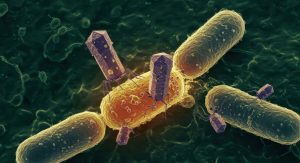
Viruses are usually associated with disease. But our bodies are full of bacteria and viruses that constantly multiply and interact with each other in our gastrointestinal tract. While we have known for decades that gut bacteria are important in young children to protect them from chronic diseases later in life, our knowledge of the many viruses found there is minimal. A few years ago, Dennis Sandris Nielsen, a professor at the University of Copenhagen, came up with the idea of investigating this question more closely. As a result, a team of researchers from COPSAC (Copenhagen Prospective Studies on Asthma in Childhood) and the Department of Food Science at UCPH, among others, spent five years examining the contents of diapers from 647 healthy one-year-old children in Denmark.
“We found an unusually high number of unknown viruses in the stools of these babies. Not only were there thousands of new virus types, but to our surprise, the viruses belonged to more than 200 virus families that had not yet been described. This means that healthy children are exposed to an extreme diversity of gut viruses from an early age, which is likely to have a major impact on whether they develop various diseases later in life,” says Professor Dennis Sandris Nielsen from the Department of Food Science, lead author of the research paper on the study published in Nature Microbiology. The researchers found and mapped a total of 10,000 virus species in the children’s stool—ten times more than the number of bacterial species found in the same children. These virus species are spread across 248 different virus families, of which only 16 were previously known. The researchers named the remaining 232 unknown virus families after the children whose diapers made the study possible. The new virus families now include names such as Sylvesterviridae, Rigmorviridae, and Tristanviridae.
Bacterial Viruses are Our Allies
“This is the first time that such a systematic overview of virus diversity in the gut has been compiled. It provides a completely new basis for research into the importance of viruses for the development of our microbiome and immune system. Our hypothesis is that at the age of one, the immune system has not yet learned to separate the wheat from the chaff, which is why an extraordinarily high diversity of intestinal viruses develops, which is probably necessary to protect against chronic diseases such as asthma and diabetes later in life,” explains Shiraz Shah, first author and lead researcher at COPSAC. Ninety percent of the viruses found by the researchers are bacterial viruses – so-called bacteriophages. These viruses have bacteria as hosts and do not attack the children’s cells, so they do not cause disease. The hypothesis is that bacteriophages primarily serve as allies: “We assume that bacteriophages are largely responsible for shaping the bacterial communities and their function in our intestinal tract.

Some bacteriophages can give their host bacteria properties that make them more competitive by integrating their own genome into the bacterium’s genome. In this case, a bacteriophage can improve a bacterium’s ability to absorb different carbohydrates, for example, allowing the bacterium to metabolize more substances,” explains Dennis Sandris Nielsen. It also appears that bacteriophages help to keep the gut microbiome in balance by keeping individual bacterial populations in check, ensuring that there are not too many of a single bacterial species in the ecosystem. It’s a bit like the populations of lions and gazelles in the savannah. Viruses, bacteria, and the immune system most likely interact and influence each other in a kind of balance. Any imbalance in this relationship is likely to increase the risk of chronic disease. The remaining ten percent of viruses found in children are eukaryotic, meaning they use human cells as hosts. These can be both friends and enemies to us.
Important Role in Inflammatory Diseases
Researchers have not yet discovered where the many viruses in one-year-olds come from. Their best answer so far is: from the environment. As Shiraz Shah points out, the entire field of research points to a huge global health problem: “Much research suggests that most chronic diseases we know of – from arthritis to depression – have an inflammatory component. This means that the immune system is not functioning as it should – possibly because it has not been properly trained. So if we learn more about the role of bacteria and viruses in a well-trained immune system, we can hopefully prevent many of the chronic diseases that so many people suffer from today.” Research groups have begun to investigate the role of gut viruses in relation to a number of different diseases that occur in childhood, including asthma and ADHD.
Bacteriophages
- There are generally two types of bacteriophages. Virulent bacteriophages take over the bacteria and produce 30 to 100 new virus particles inside them. The bacterial cell then explodes from the inside and the new virus particles are released into the environment. Virulent bacteriophages help to maintain the balance of the ecosystem in the gut.
- So-called temperate bacteriophages can reproduce by integrating their genetic material into the genome of the host cell. When the cell divides, the bacteriophage also divides. Temperate bacteriophages help transfer new genes to bacteria, making them more competitive. However, there are also studies that suggest that an imbalance in the population of temperate bacteriophages is associated with various diseases, such as inflammatory bowel disease.
Viruses
- A virus is a microorganism consisting of a genome—either DNA or RNA—surrounded by a protein membrane. Viruses cannot reproduce.
Instead, a virus attacks a host cell, which it uses to make copies of itself. Viruses are classified into virus families, which are in turn divided into a larger number of virus genera and virus species. A well-known example of a virus family is the coronavirus, which includes the viruses Covid-19, MERS, SARS, and several cold viruses.


